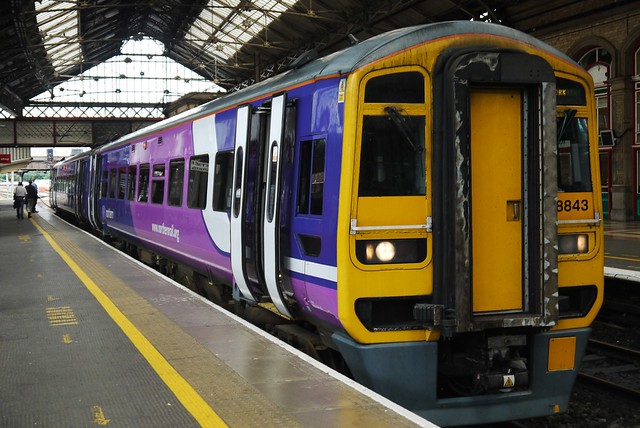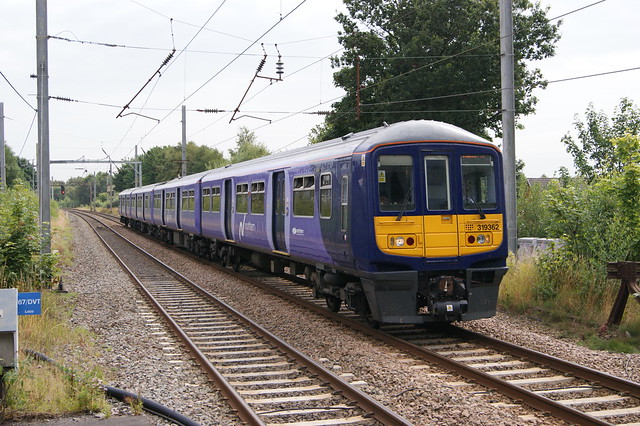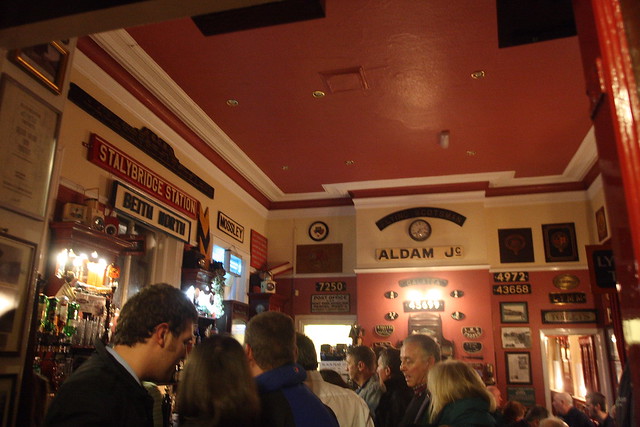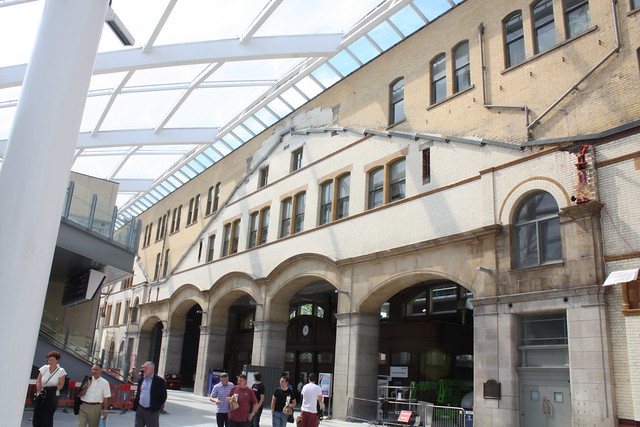Ten key characteristics of Serco/Abellio’s 12-year franchise term

By the start of next month, the Northern franchise will be taken over by Arriva/Deutsche Bahn Rail. This will be Arriva’s second stint with a Northern English heavy rail franchise (the previous being Arriva Trains Northern) and, most notably, it entails the withdrawal of Class 142 and Class 144 railbuses.Right now, Northern Rail’s elliptical logo is being airbrushed from trains, its managed stations, and publicity material. In place would be a minimalist dark blue circle with a lower case ‘n’ followed by ‘Northern’ in lower case text.
For our Not So Perfect Ten, we focus on the rail franchise that has served our area east of the M60 motorway since 11 December 2004 (on the eve of the new timetable). I remember the day very well, as I travelled to Barrow-in-Furness for a Stalybridge Celtic game. After a good pint at The Furness Railway (a good little ‘Spoons, now with hotel facilities), my father and I walked up Holker Street to see the ‘Bridge lose 2-1.
Enough of the football, here’s our Not So Perfect Ten:
- The Franchise Agreement;
- Gross Overcrowding;
- Pacer Units;
- Old Rolling Stock;
- Loco-Hauled Trains;
- Northern Powerhouse;
- Livery;
- The Rail Ale Trail;
- Evening Peak Hour restrictions;
- Manchester Victoria’s New Roof.
* * *
1. The Franchise Agreement
In 2004, the newly created Northern franchise application (merging the former Regional Railways North East and North West Regional Railways boundaries) grossly underestimated the area’s capacity growth.
In a move that would bite Serco’s posterior for the next twelve years, the agreement proposed zero growth. There was no budget for new trains, which their predecessors had in 1997. Furthermore, what was First North Western’s pride of the line (the Class 175 Coradia DMUs with built-in FM radios on the armrests) were moved to Arriva Trains Wales.
Within five years, there was staggering growth in passenger demand – rises of 50% to 80% in that period. What turned out to be The Office of the Rail Regulator’s “guitar groups are on the way out” moment led to our second feature of Serco/Abellio’s tenure.
2. Gross Overcrowding
A combination of inadequate rolling stock, rising passenger numbers and limited capacity led to the inevitable: gross overcrowding. At one point, journeys on the Manchester Victoria to Huddersfield all-stations service had 150 passengers standing up for every 70 people sat down. The overcrowding – even now – can get to a point where passengers may faint.
Former Stalybridge and Hyde MP, James Purnell responded to a constituent’s plea to take an overcrowded AM peak hour journey from Stalybridge to Manchester Victoria. He was shocked beyond belief, leading the MP – and his successor, Jonathan Reynolds, to campaign for better rail services from Mossley and Stalybridge.
The train that Mr Purnell took was a Class 142 Pacer unit. At present, they are still seen on the all stations train to Huddersfield, though Class 150s and 156s take centre stage.
3. Pacer Units

No mention of Northern Rail’s distinguishing features should omit the Class 142 and 144 railbus units. A true Northern English train in body and soul, they are based on the Leyland National bus from 1969, built in Workington. The 144s were bodied by Alexander whereas the 142s have the original bus body, built at British Leyland’s Lillyhall works (part of which is Stagecoach’s Cumberland depot).
Throughout its operating life, the stop-gap solution for lightly used lines have seen the DMUs on peak hour workings. Under British Rail, they were seen between Holyhead and Hull (!), and from Scarborough to Sheffield (via Hull Paragon and Doncaster). Originally, they were designed for lines where conventional trains were less viable. In the end, the Pacers proved to be more costlier than the Sprinter units, owing to gearbox problems.
In the run-up to privatisation, their life was extended with Leyland TL11 6-cylinder engines replaced by Cummins LTA10-R 6-cylinder engines. During privatisation, many were refurbished in various guises. Some with full height seating (Metro West Yorkshire PTE), dual-purpose bus style seating (NEXUS Tyne and Wear PTE), standard bus seats (First North Western), and individual bus seating (Merseytravel PTE – as seen in the picture above).
Hopefully, by 2019, we shall be saying ‘good night and good riddance’ to these quirky units. Even so, one of them should be preserved for the nation – in its original British Rail Provincial Sector livery with the proper bus seating. Possibly as a warning of ‘How Not To Design a DMU’.
4. Old Rolling Stock
For most of its tenure, ageing rolling stock has been a big deal throughout the Serco/Abellio years – all the more galling given its franchise terms. As a consequence, Northern Rail – plus Northern England’s Passenger Transport Executives – have had to fight for every scrap of cascaded carriage, DMU or EMU. A number of cascaded Class 150/1 Sprinter units from London Midland were bitterly fought over. As a stop-gap solution, our newly electrified railway will be operated with Class 319s, hitherto seen on Thameslink services.
Furthermore, its Class 323s will be heading to London Midland – in spite of being new to North West Regional Railways and GMPTE (they had the second GMPTE livery, the two tone grey one with the tangerine stripe). As stated earlier, the Metro-Cammell-built Class 175 Coradia units went to Arriva Trains Wales, where they are seen on the Cardiff Central to Manchester Piccadilly service.
On odd occasions, loco-hauled trains were seen on the service via Shrewsbury and Newport. Today, they are seen north of Preston, in equally scenic territory.
5. Loco-Hauled Trains

For the enthusiasts, Northern Rail have rewarded us with some loco-hauled workings. With the inter-city franchisees eschewing locomotives and carriages for fixed-formation train sets, this meant a surplus of serviceable Mark 2 and Mark 3 carriages. Firstly, there was former ‘Club’ train from St. Annes-on-the-Sea to Greenbank (west of Northwich), with four Mark 2d carriages topped and tailed by Class 31 diesel locos.
In late October 2009, floods besieged the Derwent valley from Cockermouth to Workington. With the northern and southern parts of Workington severed by its lost road bridge, the answer lay on their doorstep. Thanks to DRS (Direct Rail Services) and the Army, a makeshift station – known as Workington North – ferried passengers from the temporary station to Workington station. Again, Mark 2 carriages, though topped and tailed with Class 47 Sulzer power.
In December 2014, diesel haulage was a useful ally in providing extra trains from Preston to Manchester Victoria. This was brought in as reinforcements for passengers going to Manchester’s Christmas Market.
In 2015, with some modifications and Department for Transport funding, loco-hauled trains became the norm from Barrow-in-Furness to Carlisle. For the service via the Cumbrian Coast line, Mark 2d carriages were tastefully refurbished. Bars were added to door windows, owing to restricted clearances on the Cumbrian Coast line.
6. Northern Powerhouse

Forget the Northern Powerhouse concept or hyperbole under Osbornian direction. For our Not So Perfect Ten, we refer to one of the cascaded Thameslink Class 319 EMUs. In particular, 319362, also known as Northern Powerhouse. This was one of the first two Class 319s to reach Greater Manchester, on the semi-fast service from Manchester Victoria to Liverpool Lime Street.
Unveiled by Chancellor of the Exchequer, George Osborne, it has – ironically – had an high failure rate among the initial duo. We sincerely hope that Graham Farish’s soon-to-be-released ‘N’ Gauge model has a better reliability rate with its 5-pole motor (on pre-order from Hattons, Liverpool, for £144.46 and £4.00 carriage at this time of writing).
Though older than the Class 323s she is likely to replace, my experience of the 319s (from Manchester Airport to Manchester Piccadilly) was a positive one. Mine coincided with the announcement of the initial Northern Hub plans being ‘paused’.
7. Livery
On commencement, Northern Rail had a plethora of liveries to replace. First, the liveries of Passenger Transport Executives (the yellows of Merseyside and Tyne and Wear for example). Also the liveries of First North Western, Arriva Trains Northern and a handful of trains in Regional Railways colours. Even a number with traces of the original North Western Trains and Northern Spirit liveries.
Come 2005, there was a few prototype liveries based on Northern Rail’s corporate colours. Some with 45° angles with greater areas of light grey. Another version perpetuated the acute angles with the livery we knew and loved. Whereas all the other PTE liveries were superseded by the blue and purple, some of Metro West Yorkshire’s rolling stock retained the dark red. There was one concession to Northern’s livery with a bit of dark blue relief.
Whereas most of the PTE area’s carriages were owned by train leasing companies, Metro owned theirs. This was true of the centre carriages for the Class 144s and the eight surviving Class 155 DMUs.
8. The Real Ale Trail

Sticking with Yorkshire for our eighth point is an institution which spawned a monster. The Real Ale Trail was created by a journalist of The Independent. In 2009, Oz and James Drink to Britain extolled the joys of the trail. The rest, as they say… well, started off with good intentions.
The original premise of hopping on and off a train, and enjoying a steady pint at, for instance, Stalybridge Station Buffet Bar or The Sportsman [in Huddersfield] was scotched. It became a popular pastime for Stag and Hen Dos. Instead of its original premise, the atmosphere was more debauched. Instead of Silver King, its marauding hordes wanted Stella. Therefore, pubs along the line ceased selling the mainstream lager and cider brands, such as Carling and Strongbow.
So much so that plastic glasses are the norm on Saturdays. Sometimes, British Transport Police’s patrol of the line from Stalybridge to Huddersfield is akin to a match day operation outside Old Trafford or Elland Road. Families and individuals, who would have expected a moderately quiet post-shopping train journey, would see their senses assaulted by the yattering hordes of Bugs Bunnies and Batpeople.
9. Evening Peak Hour restrictions
By 2013, more and more people took to the trains in Northern’s metropolitan areas. Even so, the Department for Transport wanted to make the Northern franchise more cost-effective. Which, in other words, means an under-handed way of cutting their subsidy (aye, Westminster couldn’t be doing with these Northern Monkeys travelling for the price of a Freddo bar after 7pm).
Northern Rail was given two options. One was to introduce an evening peak; another was to bring in parking charges. The latter would have peed off the North’s motoring lobby, which successfully killed off Greater Manchester’s Transport Investment Fund bid in 2008. On the other hand, some thought free parking was a driver’s subsidy, and that parking charges wouldn’t penalise the carless.
Instead, an evening peak was introduced, on trains within Greater Manchester, Tyne and Wear, both West and South Yorkshires, and selected journeys to Harrogate or Skipton from Leeds. With the abolition of cheap evening fares after 6.30pm (in Greater Manchester), some passengers in September 2014 saw fare rises of up to 150%. As high as the fare rise that South Yorkshire PTE had to make in the run-up to bus deregulation.
As a consequence, some PM peak trains (from my observations) seem to be less busier. Its effect could be seen on bus routes out of Manchester, and in higher passenger loadings on Metrolink trams (where there isn’t an evening peak). Furthermore, an off-peak ticket from Stalybridge to South Milford could be a cheaper option than a fare to Leeds, if travelling on the 1741 Hull train out of Manchester Piccadilly.
10. Manchester Victoria’s New Roof

For our final point, we decided to finish on a happier note. Five years into Serco’s franchise, Manchester Victoria was voted as one of Britain’s worst railway stations. Its main peeves were the leaky roof, its seedy toilets, tired buffet bar, and the Birmingham New Street tribute act that is platforms 3 to 6.
By then, Something Had To Be Done. The roof had leaked for over a decade, prompting the closure of the Metrolink’s Bury platform. It was dark, dank, and the amount of neglect was so great, that it didn’t even justify a “due to today’s wet weather” message, as heard at its glamorous sibling on London Road and Store Street.
Its new roof, made from the same materials as the roof at Eden, Cornwall, was part of the station’s refurbishment plan. One that dispensed with the seedy gents’ toilets (it is now 30p for doing what comes naturally after a few espressos from Java). Other aspects include new stairs and walkways to the Manchester Arena, automatic barriers, and a refurbished buffet bar.
Today, the main train hall of Manchester Victoria is airier than ever, though the through platforms retain their subterranean feel. That is due to the Manchester Arena, constructed at a time when Greater Manchester’s railways were in decline. Today, Manchester Victoria’s approaches are constricted by this section. Would today’s traffic cope better if the previous layout was retained (platforms 11 to 16)?
Greetings to the New Franchisee
Arriva’s arrival has had mixed feelings among the North’s rail passengers. Some of us may remember having to detrain at Huddersfield for a toilet stop, as the bogs on the Transpennine Express train were clogged up. Others may remember Stalybridge’s apology of a Transpennine Express service (which was greatly improved on strike days).
This time, the task at hand is easier than its predecessors. The main aspects being a set of new uniforms, yet another new livery, and the promise of new trains. Its hardest task will be the implementation of new technology and having to make further economies (especially Smart Ticketing and the spectre of Driver Only Operation). The focus on the franchise is expansionist on one hand, yet likely to be reductionist on a staff level. Such as the status of conductor guards; also as to whether or not ticket office staff should be selling Kit Kats in addition to All-Line Rover tickets.
For many passengers, the biggest win may be the torching of Class 142 and Class 144 Pacer units. That’ll win new passengers. For once, the trains could be on a par with the rail replacement buses instead of being inferior to them! If you thought Northern Rail had more sheds than B&Q, or tried to offer an Hollywood service on Ed Wood’s budget, their like shall never be forgotten.
S.V., 29 March 2016.

Its all very well decrying the cut in subsidy from Autumn 2014, but Northern Rail as a whole had a whopping £700 million of tax-payers money – they highest in England. That might be all very well in maintain transport links in rural Cumbria or North Yorkshire, but should it really be used to abstract revenue from commercial bus services like the 203, and similarly in Leeds – Especially if it generates car traffic from home to Station? Apparently, Arriva will be running the new franchise for barely £200 million, which begs the question, were Serco defrauding the Tax-payer by half a BILLION pounds a year, when bus services are slashed for a few thousand here and there?
As regarding PM peak trains being less busy. You want to try catching the 1649 stopper to Sheffield – actually don’t, there is no room. Easily the busiest train on the Hope Valley Line, this is the only one relying on a single two-car unit. Worse still, its a 150, which I think are worse than 142s. On 142s, people will move down the aisles, stand in the door well and (whisper it), if its 2×2 seating, they will actually occupy seats, normally meant for shopping bags, lap-tops and Metro Newspapers. 150s are an obstacle course, where its impossible to grab hold of a grab rail.
As an intersting post script, there are no trains through Reddish next week, whilst the viaduct is being worked on. Consequently, the question I heard asking wasn’t “What time do the Rail Replacements run?”, but “How much are MegaRiders nowadays?”
LikeLike
Hi Phil,
As to whether or not Serco did defraud the taxpayer is a good question. Not only its Northern Rail franchise but also any of its other contracts it had won, such as the probation deal (a £37m contract cut short). Also its prisons. I would have favoured parking charges in urban stations, which would have made the bus option more attractive. Not only for first and last mile journeys to and from the railway station, also some longer distance routes.
Another problem is that, in spite of being Britain’s most popular form of public transport, buses have never been seen as ‘sexy’ by governments red and blue in the last 40 years. For progressive and expansionist bus policy, seldom outside London and Metropolitan areas. Hence the age of seventeen being seen as a one-way bus ticket out of catching a single bus again.
You are spot on with your observations on the Class 150 units. When I used to get the 0817 train to Altrincham via Stockport, I hated the Merseytravel PTE style Pacers (seating – need I say more as you can testify from past experience), and I was never too impressed with the Class 150 Sprinters. Owing to the lack of tables, it (as you said) wasn’t unusual to see suitcases, shopping bags or newspapers occupying seats. This was marked on the middle seat of a triple seated section (within the 2+3 seating layout on the said units).
On the bus-seated Pacers, I always place my rucksack under the seat or use the overhead luggage racks. Could the Sprinter’s layout have been improved by grab rails on the edge of the luggage racks (as seen on the Class 323s)? I think the door positions on the 150s hardly help; sometimes, the lack of cycle racks have meant bicycles being placed in the door well.
As for people asking for MegaRider prices instead of rail replacement bus timings, I find that gratifying, knowing the reputation that bus replacement services have (inconsistent rolling stock, arcane journey times). I wonder how many people from Reddish might consider the 203, then use their MegaRiders for travel elsewhere on Stagecoach’s network? As for the people of Romiley, this is where the 207 service would have come into its own at one time.
Bye for now,
Stuart.
LikeLike